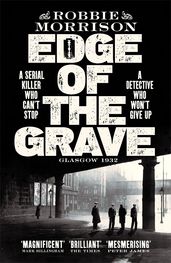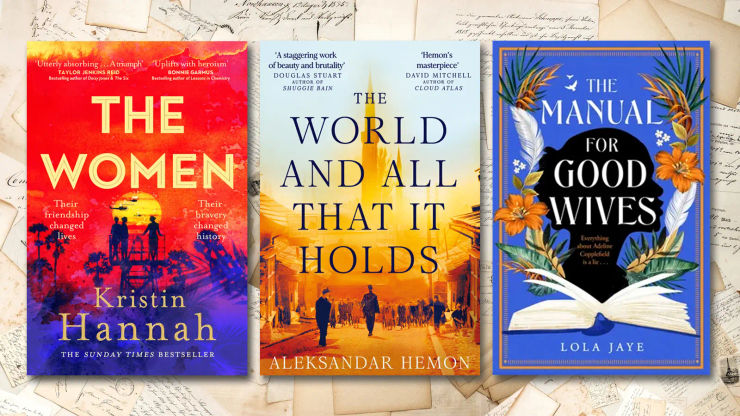Robbie Morrison and the lawless streets of 1930s Glasgow
Edge of the Grave is a rich mix of fact and fiction, drawing on author Robbie Morrison’s family history and a wealth of other sources in its recreation of cloak and dagger 1930s Glasgow.

In 1932 Glasgow was sunk in the Great Depression, lawless, fast-talking and with streets ruled by razor gangs. In stepped an English police constable, who enlisted hardy highlanders to help him gain control of the city. Author of Edge of the Grave Robbie Morrison tells us how he researched the fascinating backdrop of a city in transition, taking his father’s family history, hard-boiled crime fiction and a contemporary police memoir as inspiration.
Edge Of The Grave is the first book in a new historical crime series set in 1930s Glasgow. It’s a gritty thriller that mixes fact and fiction, taking protagonists Detective Inspector Jimmy Dreghorn and his sergeant ‘Bonnie’ Archie McDaid from the flying fists and slashing blades of the gangland underworld to the backstabbing upper echelons of government and big business in the hunt for a twisted killer.
The title derives from a quote from The Papers Of Tony Veitch by the late William McIlvanney, a writer capable of achieving greater insight in one sentence than most of us could in an entire novel: ‘it was as if Glasgow couldn’t shut the wryness of its mouth even at the edge of the grave.’
Edge Of The Grave is set in 1932, with Glasgow still recovering from the Great War and the Spanish Flu pandemic, now deep in the grip of the Great Depression. It’s a raucous, lawless city with corruption, poverty, unemployment, extremist politics, sectarianism, the streets terrorised by razor gangs – in other words, the perfect location for a crime series.
My fascination with the 1930s stems from a number of sources. My family history (handily compiled by my father), which has connections to shipbuilding stretching back four generations on both sides. My love for the hard-boiled crime fiction of that period, from Dashiell Hammett to Raymond Chandler, and the gangster films of James Cagney and Humphrey Bogart – whose sharp-suited, fast-talking protagonists also influenced the street gangs of the time. And, of course, Glasgow itself, as colourful a character in its own right as you’ll ever find.
I wanted to write a story that would capture the power and drama of the era – the spirit of the people and the spirit of the city and how they make each other what they are – but hopefully also have resonance in our world now. Reading up on the period, I found the perfect inspiration: Cloak Without Dagger, the autobiography of Percy Sillitoe, Glasgow’s chief constable from 1931 to 1942.
‘I wanted to write a story that would capture the power and drama of the era – the spirit of the people and the spirit of the city and how they make each other what they are – but hopefully also have resonance in our world now. ’
In an effort to clean up the city, the Corporation of Glasgow controversially appointed Englishman Sillitoe as the new chief constable. He recruited the biggest, toughest officers in Scotland, often from the highlands and islands, and radically restructured the force, which was the second largest in Britain after the London Met. Later appointed director of MI5, Sillitoe also formed what was essentially the UK’s first modern flying squad, plainclothes detectives patrolling the streets in high-speed radio-cars. His message to criminals was blunt: the biggest gang in this city is the Glasgow Police Force.
This squad was nicknamed ‘the Untouchables’ by the press, after the elite unit put together in 1920s Chicago by FBI agent Eliot Ness to target gangster Al Capone. For the novel, I’ve embellished this to ‘the Tartan Untouchables’ – a quip from my partner, Deborah Tate, a Marvel Comics trained editor who helped immensely behind the scenes with the book. Having parents born in that era, she also grew up fascinated with the period and had her own affection for Glasgow.
Edge Of The Grave focuses on two of these Tartan Untouchables, Inspector Jimmy Dreghorn and his sergeant ‘Bonnie’ Archie McDaid, hardened veterans of World War One. Dreghorn’s background is partly inspired by my paternal grandfather, a boilermaker/caulker who worked in black squads in various Clyde shipyards and boxed for a time under the patronage of Sir Iain Colquhoun, whose family home of Rossdhu, Luss is now the Loch Lomond Golf Club, elements which are fictionalised in the story. McDaid is based upon a real policeman of the period, a larger-than-life Olympic medal-winning wrestler, police boxing champion and bagpipe player.
In the course of the novel, they encounter many other real-life figures: Sillitoe himself, of course; Willie Kivlichan, police doctor and one of the few footballers to play for both Rangers and Celtic; Benny Parsonage, chief officer of the Glasgow Humane Society, who patrolled the River Clyde from 1918 to 1979, recovering bodies and saving thousands of people from drowning. The supporting cast also includes fictional characters who are influenced by real people: police constable Ellen Duncan, determined to tear down barriers and become Glasgow’s first female detective; Isla Lockhart, daughter of a prominent suffragette and heir to a shipbuilding dynasty; and the charismatic but deadly razor gang leader Billy Hunter.
In my early notes for Edge Of The Grave, I describe Jimmy Dreghorn as a man of ‘contrasts and contradictions: cynical and pragmatic, yet passionate and romantic; good-humoured and possessed of a lust for life, yet brooding and taciturn when faced with injustice; tough, yet tender and caring; politically aware, yet distrustful and disdainful of those who hold power; and always punching above his weight.’
Not a bad description of Glasgow either – now or in the 1930s.
Edge of the Grave
by Robbie Morrison
Perfect for fans of Peaky Blinders, Robbie Morrison’s debut is a dark historical crime novel set in a Glasgow still recovering from the war, split by religious division and swarming with razor gangs. When the son-in-law of one of the city’s wealthiest shipbuilders is found murdered, Inspector Jimmy Dreghorn is assigned to the case. But his troubled history with the victim’s widow may cause problems . . . Meanwhile, a sadistic murderer stalks the city’s streets, leaving a trail of dead bodies behind.



